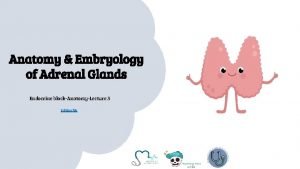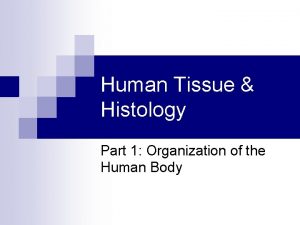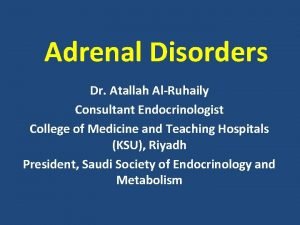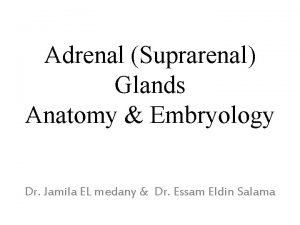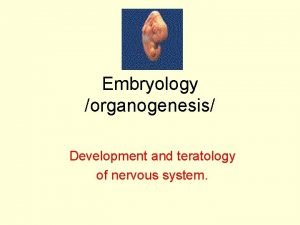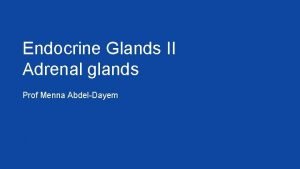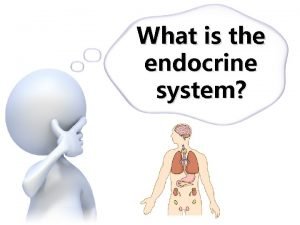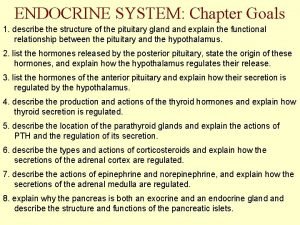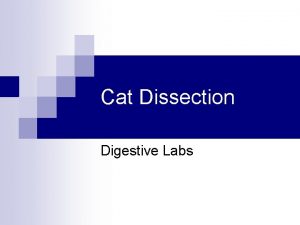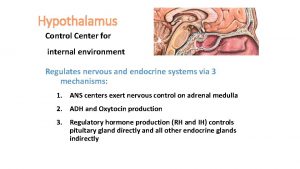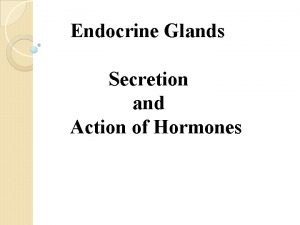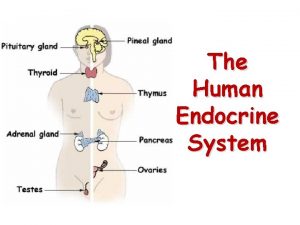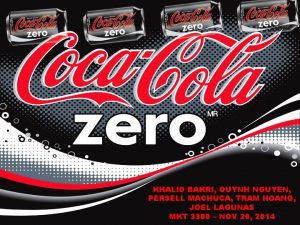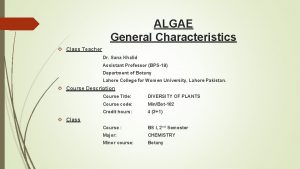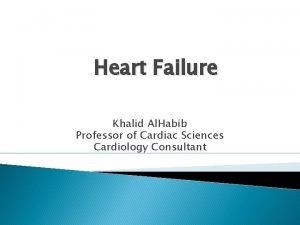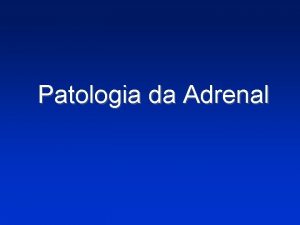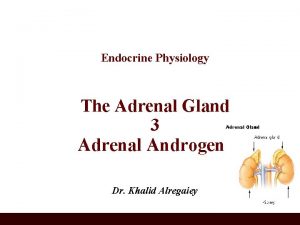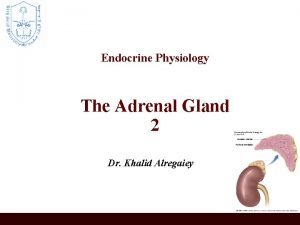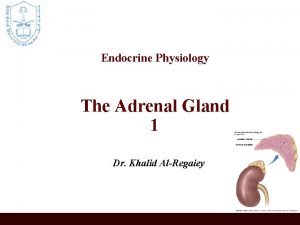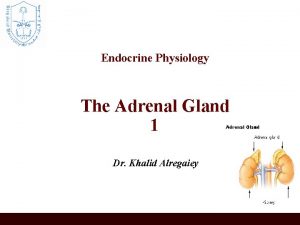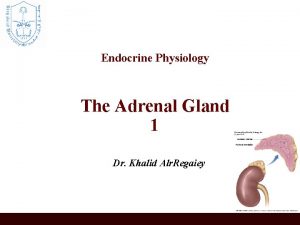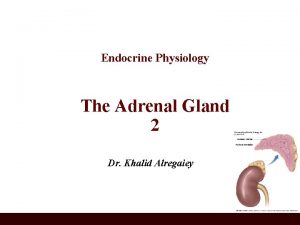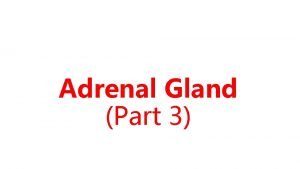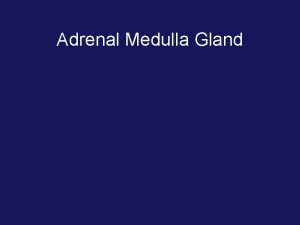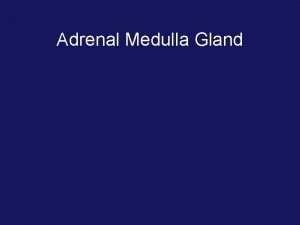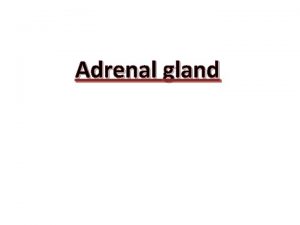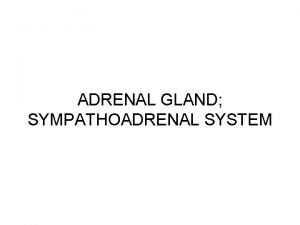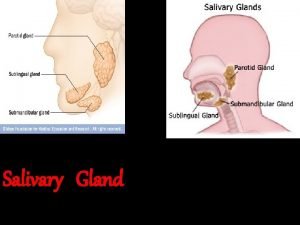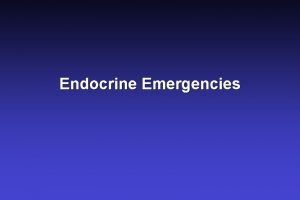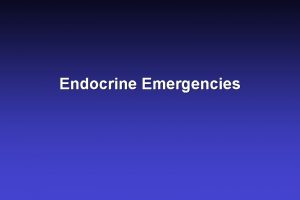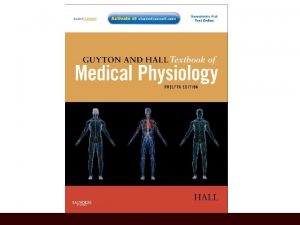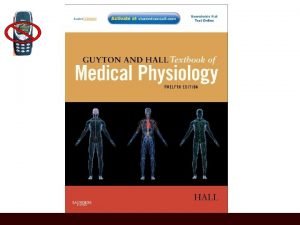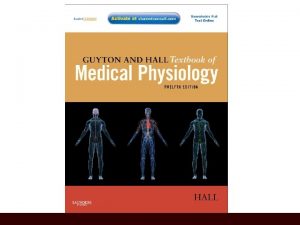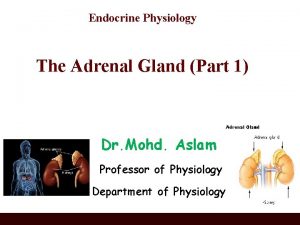Endocrine Physiology The Adrenal Gland 1 Dr Khalid




















![Actions of Aldosterone Binds to mineralocorticoid receptor [MR] Stimulates sodium reabsorption by distal tubule Actions of Aldosterone Binds to mineralocorticoid receptor [MR] Stimulates sodium reabsorption by distal tubule](https://slidetodoc.com/presentation_image_h2/d03a2904a78a2eba02d343075e839d5d/image-21.jpg)







- Slides: 28

Endocrine Physiology The Adrenal Gland 1 Dr. Khalid Alregaiey

Adrenal (Suprarenal) Glands • Adrenal glands – paired, pyramid-shaped organs atop the kidneys • Weigh 4 -10 g. • Structurally and functionally, they are two glands in one • Adrenal cortex (80 -90%)– glandular tissue derived from embryonic mesoderm • Adrenal medulla (10 -20%)– formed from neural ectoderm, can be considered a modified sympathetic ganglion

Adrenal Cortex • Synthesizes and releases steroid hormones (corticosteroids) • Different corticosteroids are produced in each of the three layers: • Zona glomerulosa – mineralocorticoids (mainly aldosterone) • Zona fasciculata – glucocorticoids +Androgens (mainly cortisol and corticosterone) • Zona reticularis – gonadocorticoids + glucocorticoids (mainly dehydroepiandrosterone DHEA)

Adrenal Cortex


HPA Axis

Steroid Hormones: Structure

Steroid Hormones Synthesis • Steroids are derivatives of cholesterol • Cholesterol is from the lipid droplets in cortical cells (cholesterol esters in LDL) • Removed cholesterol is replenished by cholesterol in LDL in blood or synthesized from acetate • Steroidogenic Acute regulatory protein (St. AR protein) transfers cholesterol to the inner membrane of the mitochondria (mutation causes accumulation of cholesterol in the cytoplasm).

Steroid Hormones Synthesis (Cont. ) • Steroid hormones are synthesized and secreted on demand (not stored) • The first step in the synthesis of all steroid hormones is conversion of cholesterol to pregnenolone by the enzyme cholesterol dismolase (aka cholesterol side chain cleavage (SCC) enzyme • Newly synthesized steroid hormones are rapidly secreted from the cell • Following secretion, all steroids bind to some extent to plasma proteins: CBG and albumin

Steroidogenesis

Genetic Defects in Adrenal Steroidogenesis • Congenital adrenal hyperplasia cortisol ACTH Adrenal hyperplasia • 21 -hydroxylase (P 450 c 21) deficiency: cortisol, corticosterone, and aldosterone deficiency *ACTH Adrenal hypertrophy and high amounts of androgen * Virilization of female (masculanization)

Loophole in the Negative Feedback

Minerlaocorticoid vs. Glucocorticoid Potency

Steroid Hormones: Action

Mineralocorticoids: Aldosterone

Mineralocorticoids: Aldosterone • A steroid hormone. • Essential for life. • Synthesized in zona glomerulosa • Responsible for regulating Na+ reabsorption in the distal tubule and the cortical collecting duct • It also affects Na+ reabsorption by sweat, salivary and intestinal cells.

Mineralocorticoids • Aldosterone secretion is stimulated by: • Decreasing blood volume or pressure (reninangeotensin system) is the major stimulant • Rising blood levels of K+ (hyperkalemia) • ACTH

The Four Mechanisms of Aldosterone Secretion • Renin-Angiotensin System (RAS), hypovolemia • Hyperkalemia: Plasma concentration of potassium directly influences the zona glomerulosa cells • ACTH – causes small increases of aldosterone during stress • Atrial natriuretic peptide (ANP) – inhibits activity of the zona glomerulosa and reduces aldosterone

The Four Mechanisms of Aldosterone Secretion

Transport and Metabolism of Aldosterone • Aldosterone binds to albumin and corticosteroidbinding protein in blood with low affinity and therefore has a biological half-life of about 20 minutes. • Aldosterone is inactivated by the liver and conjugated to a glucuronic acid or sulfate and secreted in bile or excreted by the kidney.
![Actions of Aldosterone Binds to mineralocorticoid receptor MR Stimulates sodium reabsorption by distal tubule Actions of Aldosterone Binds to mineralocorticoid receptor [MR] Stimulates sodium reabsorption by distal tubule](https://slidetodoc.com/presentation_image_h2/d03a2904a78a2eba02d343075e839d5d/image-21.jpg)
Actions of Aldosterone Binds to mineralocorticoid receptor [MR] Stimulates sodium reabsorption by distal tubule and collecting duct of the nephron and promotes potassium and hydrogen ion excretion • Increases transcription of Na/K pump (basolateral) • Increases the expression of apical Na channels and Na/Cl cotransporters (NCC) • Stimulates the secretion of K+ into the tubular lumen • Stimulates secretion of H+ via the H+/ATPase by the intercalated cells of the cortical collecting tubule

Actions of Aldosterone • Aldosterone increases extracellular fluid volume and arterial pressure but has only a small effect on plasma sodium concentration. (water is also absorbed, ADH is secreted) • Excess aldosterone not only causes loss of potassium ions from the extracellular fluid into the urine but also stimulates transport of potassium from the extracellular fluid into most cells of the body. • Excess Aldosterone Increases Tubular Hydrogen Ion Secretion and Causes Alkalosis.

Actions of Aldosterone • Aldosterone has the same effects on sweat glands and salivary glands as it has on the renal tubules, reabsorption of Na+ and Cl- and excretion of K+ • Aldosterone also greatly enhances sodium absorption by the intestines, especially in the colon


Mineralocorticoid Receptor and Cortisol

Aldosterone: Role in diseases • Complete failure to secrete aldosterone leads to death (dehydration, low blood volume). • Hyperaldosterone states: Contribute to hypertension associated with increased blood volume.

Overproduction of aldosterone • primary causes, ie. Conn’s syndrome: • adenoma, nodular hyperplasia of zona glomerulosa • secondary • left ventricular failure, cor pulmonale, cirrhosis, ascites, hyperreninism • Apparent mineralocorticoid excess syndrome (AME) (cortisol binds MR) • symptoms, signs • headache, hypokalemia causing muscle weakness, hypernatremia, hypervolemia, metabolic alkalosis, nocturnal polyuria, hand cramping

Overproduction of aldosterone • treatment • surgical for adenoma • Spironolactone, a potassium-sparing diuretic that acts as an aldosterone antagonist.
 Cells of adrenal gland
Cells of adrenal gland Nerve ganglia
Nerve ganglia Adrenal gland epithelium
Adrenal gland epithelium Acth
Acth Adrenal gland regions
Adrenal gland regions Adrenal gland relations
Adrenal gland relations Neural plate
Neural plate Adrenal gland regions
Adrenal gland regions Adrenal gland hormones
Adrenal gland hormones Hypoglycemic shock
Hypoglycemic shock Left ureter
Left ureter Hypothalamus
Hypothalamus Ectocrine
Ectocrine Secretory gland
Secretory gland Estrogen effect
Estrogen effect Pituitary gland and pineal gland spiritual
Pituitary gland and pineal gland spiritual Pineal gland pituitary gland
Pineal gland pituitary gland Physiology of thyroid gland
Physiology of thyroid gland Khalid bakri
Khalid bakri Khalid karaoui
Khalid karaoui Sana khalid
Sana khalid Nationality vs citizenship
Nationality vs citizenship Khalid al habib
Khalid al habib Khalid bazaid
Khalid bazaid Dr. khalid bazaid
Dr. khalid bazaid Complete the tag question your name is ali khalid
Complete the tag question your name is ali khalid Welcome to english class
Welcome to english class Dr khalid jamal
Dr khalid jamal Quarter turn belt drive
Quarter turn belt drive
